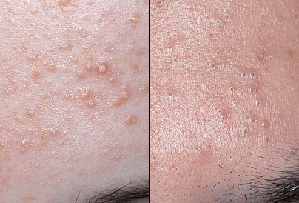Acne is present in almost all adolescents, with 85% minimal acne, 14% moderate acne, and 1% severe nodulocystic, suppurating, and recurrent acne. It almost always disappears in adulthood.
Acne is not an infectious disease, but an inflammatory involvement of the sebaceous glands appended to the hair follicles (Faure, 1993).
Initially, there is hyperkeratinization, i.e. increased proliferation of the epithelium of the sebaceous gland duct, and simultaneously an exaggerated production of sebum or seborrhea, favored by androgens, which explains the male predominance. The sebaceous gland canal and the hair follicle are soon completely blocked by this waste, and bacterial colonization occurs. This is how the comedo or blackhead is formed. This comedo can trigger an inflammatory reaction that leads to a pustule. Lesions usually predominate on the face and chest. Superficial acne heals without leaving any traces, but deep acne can leave scars.
As the etiology of this disease is not yet known, conventional medicine is again at a loss as to the background treatment of this condition.
Researchers have found large amounts of vitamin A in comedones (blackheads), which is why Dr. Stanway says that acne sufferers have lower than normal levels of vitamin A in their blood. If you feel you are getting enough from your diet and you have acne, don't hesitate to increase your dietary intake of vitamin A to compensate for this loss. People with acne often have a zinc deficiency. It is recommended that they regularly include the following foods in their menu: shellfish (oysters and lobster in particular), peanuts, pecans, legumes, liver and turkey.
If you are prone to acne, however, avoid consuming too much iodine on a regular basis. Excessive iodine intake can irritate tissues and cause acne outbreaks. Salt is not the only thing that contains iodine. Analyses have shown that many of the fast foods, as well as milk, contain significant amounts of iodine. The U.S. Consumer's Union has already shown that the average iodine intake of a fast food meal would provide 30 times more iodine than the recommended dietary allowance (RDA) by health authorities. Seaweeds, especially those used to wrap Japanese sushi, are also very high in iodine; kelp, a variety of brown seaweed, remains the highest known source of iodine. Shrimp and shellfish also contain them, although in smaller quantities.

We consider this epithelial and seborrheic proliferation as an elimination of macromolecules, transported from the blood to the sebaceous glands, in order to be rejected outside the body by the secretion of these glands. Blackheads and pustules are only the manifestation of this elimination. It therefore seems logical once again to rebalance the diet in order to reduce the amount of waste to be eliminated, while making up for any deficiencies.
Eat more foods containing zinc, lecithin, selenium and vitamins A, B6, C and E, as well as more raw fruits and vegetables (especially green leafy vegetables and those containing vitamin A). Fresh beet or carrot juice can help supplement this intake. Crushed raw garlic (about three cloves per day) is also very useful. Once the acne begins to clear up, continue the regimen to prevent any recurrence. Some people assume that certain foods, such as chocolate, make acne worse, but this has not been confirmed by research.
The results obtained by the application of a balanced diet are remarkable; however, one must be well aware that one cannot unfortunately erase the pre-existing scars from previous flare-ups.
Vitamins A, B3, B5 and B6 have an important role to play in the treatment of acne. Zinc is a key element in the treatment of acne, and in most cases, it makes it possible to do without antibiotics. A superb alternative to antibiotics is offered to us by essential oils whose anti-infectious properties are well known.



